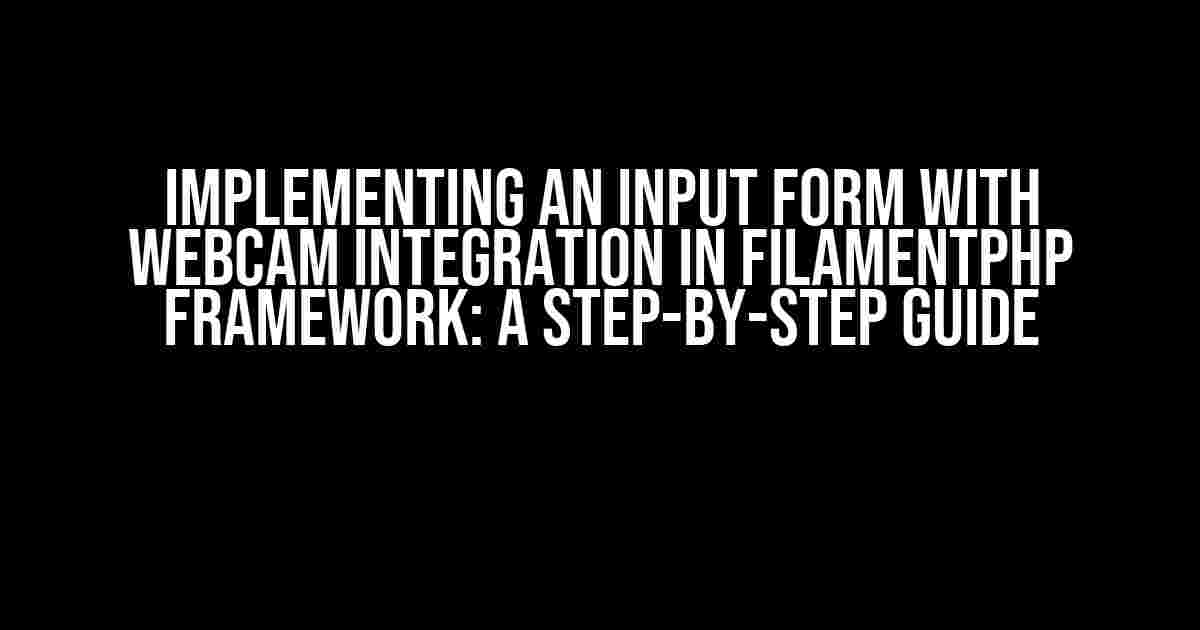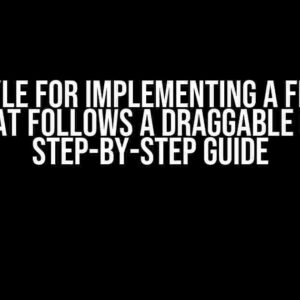Welcome to this comprehensive tutorial on implementing an input form with webcam integration in FilamentPHP framework! In today’s digital age, leveraging webcams to enhance user experience is becoming increasingly popular. With FilamentPHP, you can create robust and efficient applications with ease. In this article, we’ll take you through a step-by-step process to integrate webcam functionality into an input form using FilamentPHP framework.
Prerequisites
Before we dive into the implementation process, ensure you have the following requirements checked:
- Basic understanding of PHP and HTML
- FilamentPHP framework installed on your system
- A webcam connected to your system (obviously!)
- A code editor or IDE of your choice
Step 1: Setting up the Project Structure
Let’s create a new FilamentPHP project. Open your terminal/command prompt and run the following command:
composer create-project filament-php/framework my-webcam-projectThis will create a new FilamentPHP project named “my-webcam-project”. Navigate into the project directory:
cd my-webcam-projectCreate a new directory named “resources” within the project root. This is where we’ll store our HTML, CSS, and JavaScript files:
mkdir resourcesStep 2: Creating the Input Form HTML
Create a new file named “index.html” within the “resources” directory:
touch resources/index.htmlOpen “index.html” in your code editor and add the following HTML code:
<!DOCTYPE html>
<html>
<head>
<title>Webcam Input Form</title>
<script src="https://cdn.jsdelivr.net/npm/@filament-php/[email protected]/dist/filament.min.js"></script>
</head>
<body>
<h1>Webcam Input Form</h1>
<form id="webcam-form">
<label>Name:</label>
<input type="text" id="name" name="name"><br><br>
<label>Webcam Capture:</label>
<video id="webcam-video"></video>
<button id="capture-button">Capture</button>
<input type="hidden" id="captured-image" name="captured-image">
</form>
</body>
</html>This HTML code creates a basic input form with a text field for the user’s name, a video element for displaying the webcam feed, a capture button, and a hidden input field to store the captured image.
Step 3: Implementing Webcam Integration using JavaScript
Create a new file named “script.js” within the “resources” directory:
touch resources/script.jsOpen “script.js” in your code editor and add the following JavaScript code:
const webcamForm = document.getElementById('webcam-form');
const webcamVideo = document.getElementById('webcam-video');
const captureButton = document.getElementById('capture-button');
const capturedImageInput = document.getElementById('captured-image');
// Request access to the webcam
navigator.mediaDevices.getUserMedia({ video: true, audio: false })
.then(stream => {
webcamVideo.srcObject = stream;
webcamVideo.play();
})
.catch(error => {
console.error('Error accessing webcam:', error);
});
// Capture image on button click
captureButton.addEventListener('click', () => {
const canvas = document.createElement('canvas');
canvas.width = webcamVideo.videoWidth;
canvas.height = webcamVideo.videoHeight;
const ctx = canvas.getContext('2d');
ctx.drawImage(webcamVideo, 0, 0, canvas.width, canvas.height);
const imageDataURL = canvas.toDataURL();
capturedImageInput.value = imageDataURL;
});This JavaScript code requests access to the user’s webcam, displays the webcam feed in the video element, and captures an image when the capture button is clicked. The captured image is then stored in the hidden input field as a data URL.
Step 4: Handling Form Submission in FilamentPHP
Create a new file named “WebcamFormController.php” within the “app/Http/Controllers” directory:
touch app/Http/Controllers/WebcamFormController.phpOpen “WebcamFormController.php” in your code editor and add the following PHP code:
<?php
namespace App\Http\Controllers;
use Illuminate\Http\Request;
class WebcamFormController extends Controller
{
public function handleSubmit(Request $request)
{
$name = $request->input('name');
$capturedImage = $request->input('captured-image');
// Store the captured image in a database or perform further processing
// ...
return redirect()->route('success');
}
}This PHP code defines a controller that handles the form submission, retrieves the captured image from the request, and performs further processing (in this example, we’re simply redirecting to a success route).
Step 5: Defining Routes in FilamentPHP
Open the “routes.web.php” file within the “app/Http” directory:
touch app/Http/routes.web.phpAdd the following route definitions:
<?php
use Illuminate\Support\Facades\Route;
use App\Http\Controllers\WebcamFormController;
Route::get('/', function () {
return view('index');
});
Route::post('/submit', [WebcamFormController::class, 'handleSubmit'])->name('submit');
Route::get('/success', function () {
return 'Form submitted successfully!';
})->name('success');These route definitions map the form submission to the `handleSubmit` method in the `WebcamFormController` and define a success route that displays a success message.
Conclusion
That’s it! You’ve successfully implemented an input form with webcam integration in FilamentPHP framework. Run the project using the following command:
php artisan serveOpen a web browser and navigate to http://localhost:8000. You should see the input form with a webcam feed. Click the capture button to capture an image, and submit the form to see the captured image stored in the request.
Troubleshooting Tips
If you encounter issues with webcam access or image capture, ensure that:
- Your webcam is properly connected and configured
- You have granted access to the webcam in your browser’s settings
- The JavaScript code is executed in a secure context (HTTPS)
By following this comprehensive guide, you’ve learned how to integrate webcam functionality into an input form using FilamentPHP framework. This is just the beginning of exploring the possibilities of webcam integration in web applications. Happy coding!
| File | Description |
|---|---|
| index.html | HTML template for the input form |
| script.js | JavaScript code for webcam integration and image capture |
| WebcamFormController.php | PHP controller for handling form submission and storing captured image |
| routes.web.php | Route definitions for the input form and success route |
Remember to explore the official FilamentPHP documentation for more information on building robust and efficient applications with the framework.
Related Reading
If you’re interested in learning more about webcam integration in web applications, check out these related topics:
- WebRTC (Web Real-Time Communication) API
- MediaStream API
- getUserMedia() method
- Webcam integration in other frameworks (e.g., Laravel, CodeIgniter)
Final Thoughts
In this article, we’ve demonstrated how to implement an input form with webcam integration in FilamentPHP framework. By following these step-by-step instructions, you can create engaging and interactiveHere are 5 Questions and Answers about “Implementing an Input Form with Webcam Integration in FilamentPHP Framework” using a creative voice and tone:
Frequently Asked Questions
Got questions about implementing an input form with webcam integration in FilamentPHP Framework? We’ve got answers!
How do I set up a webcam input form in FilamentPHP Framework?
To set up a webcam input form in FilamentPHP Framework, you’ll need to install the `media` package and configure the `Webcam` component in your form. Then, you can use the `Webcam::capture()` method to capture an image from the user’s webcam and save it to your database. Easy peasy!
What are the dependencies required for webcam integration in FilamentPHP Framework?
To integrate a webcam input form in FilamentPHP Framework, you’ll need to install the `ffmpeg` and `media` packages. You’ll also need to make sure that your server has the necessary permissions to access the user’s webcam. Don’t worry, it’s a one-time setup!
How do I handle errors and exceptions when implementing webcam integration in FilamentPHP Framework?
When implementing webcam integration in FilamentPHP Framework, you can use try-catch blocks to handle errors and exceptions. You can also use the `Webcam::getError()` method to get the error message and display it to the user. Don’t worry, we’ve got you covered!
Can I customize the webcam input form in FilamentPHP Framework?
Absolutely! You can customize the webcam input form in FilamentPHP Framework using CSS and JavaScript. You can also use the `Webcam` component’s attributes to customize the form to your liking. Get creative and make it your own!
Is webcam integration in FilamentPHP Framework compatible with different browsers and devices?
Yes, webcam integration in FilamentPHP Framework is compatible with different browsers and devices, including desktops, laptops, and mobile devices. However, it’s always a good idea to test your application on different devices and browsers to ensure compatibility. Better safe than sorry!



